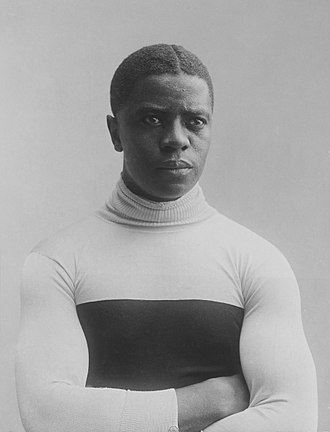 “Life is too short for any man to hold bitterness in his heart and that is why I have no feeling against anybody.” — Marshall Taylor
“Life is too short for any man to hold bitterness in his heart and that is why I have no feeling against anybody.” — Marshall Taylor
Date of birth: Nov 26, 1878 (five sisters, two brothers)
Place of birth: Indianapolis, IN (Bucktown neighborhood, near West Side)
Parents: Gilbert Taylor, Civil War veteran, Saphronia Taylor
During Marshall’s early childhood, his father, Gilbert Taylor, was employed as a coachman by a wealthy Indianapolis family, the Southards. Intermittently, from age 8 to 12, Marshall lived with the Southard family and their son, Daniel, the same age. Both boys played together and were tutored in the home. Marshall received his first bicycle as a gift from the Southards during this period.
By age 14, he had become sufficiently proficient as a ‘trick rider’ that he began to perform regularly for crowds that assembled near a local bicycle shop (where Marshall worked part-time). His nickname, “Major,” became associated with the uniform jacket that he routinely wore during his ‘act’ and was not due to military service or rank – but stuck for the rest of his life!
Major Taylor’s bicycle prowess soon came to the attention of Louis ‘Birdie’ Munger, an accomplished cyclist himself and local Indianapolis entrepreneur (owner, Munger Cycle Manufacturing Company). With Munger serving as a coach and sponsor, Major Taylor began competing in a wide variety of cycling races, focusing on the shorter (sprint) distances, but occasionally competing in multi-day distance events. Munger and Taylor relocated to Massachusetts where Major began training and competing in earnest. Avoiding alcohol and following a strict diet and training regimen, he began setting records and winning races wherever he went.
After winning the one mile sprint at the 1899 World Championship competition in Montreal, Canada, Taylor was widely recognized as one of the fastest cyclists ever, and, certainly, the first African American to achieve such distinction. His ensuing professional career took him to many races in America and Europe until he retired from competition in 1910.
In his autobiography, self-published in 1928, Taylor recounted his personal battles against prejudice and his efforts to serve as model for other emerging black athletes. Unfortunately, his success on the racetrack was not mirrored in his later personal life where he suffered a variety of business and personal setbacks. He died June 21, 1932 at the age of 53 in Chicago, nearly penniless, from complications of heart disease.
The ‘Major Taylor Velodrome’ (operated by nearby Marian University) in Indianapolis opened in July 1982, as part of the US Olympic Festival, with a construction cost of $2.5 million. Including the 1987 Pan American games, this venue has hosted many national and international cycling competitions. It is thought to be the first publicly funded structure in Indianapolis to be named after an African American.
A Special Exhibit at the Indiana State Museum, “Major Taylor: Fastest Cyclist in the World,” is open now thru October 23, 2022.
For more information:
Wikipedia: https://en.wikipedia.org/wiki/Major_Taylor (includes a lengthy list of races and World Records, as well as additional biographical details)
https://www.indianamuseum.org/experiences/major-taylor-fastest-cyclist-in-the-world/
Indy Cycloplex & Major Taylor Velodrome website: https://indycycloplex.com/ (Includes event/practice calendar and participation requirements) (adjacent to the Marian University campus on W 38th Street in Indianapolis)
